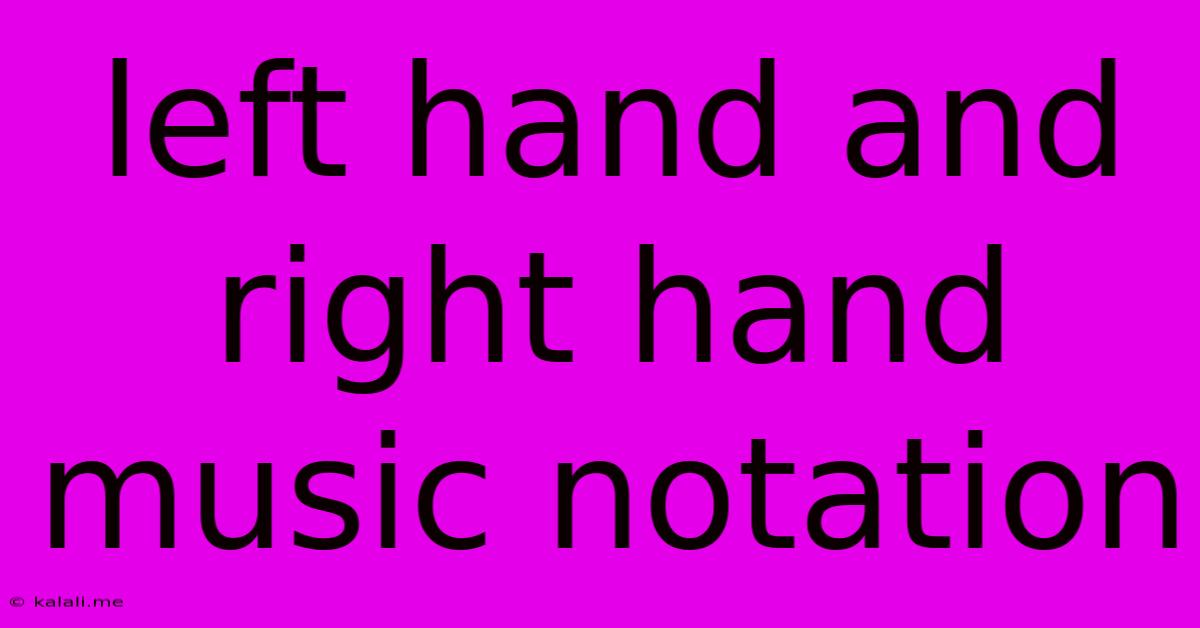Left Hand And Right Hand Music Notation
Kalali
Jun 01, 2025 · 3 min read

Table of Contents
Left Hand and Right Hand Music Notation: A Comprehensive Guide
Understanding how music notation represents the different roles of the left and right hands is crucial for musicians, especially pianists and other instrumentalists playing keyboard instruments. This guide will delve into the intricacies of left-hand and right-hand notation, clarifying how composers convey complex musical ideas across both hands. This will cover topics such as grand staff, clef signs, and common practices in musical scores.
The Grand Staff: The Foundation of Dual-Hand Notation
The grand staff is the visual representation of both the treble and bass clefs, stacked vertically. The treble clef (G clef), typically positioned on the top, denotes the higher register played by the right hand (for most instruments). The bass clef (F clef), located below, indicates the lower register for the left hand. This arrangement allows composers to clearly display the melodic and harmonic lines simultaneously.
Clef Signs and Their Significance
The clef signs are the cornerstone of understanding musical pitch. The treble clef indicates that the line on the staff immediately below the "swirl" is the G above middle C. The bass clef shows the line between the two dots is the F below middle C. These reference points allow musicians to accurately determine the pitch of each note. Understanding these symbols is fundamental to correctly reading and playing music for both hands. Incorrect placement or misinterpretation of these clef signs can lead to significant performance errors.
Interpreting Rhythmic Notation Across Both Hands
Rhythmic notation is crucial for both hands. While the melody (often in the right hand) may be the focus, the left hand provides the rhythmic and harmonic foundation. Understanding note values, rests, time signatures, and meter applies equally to both staves. Composers utilize rhythmic patterns in the left hand to complement or contrast with the right-hand melody. A strong grasp of rhythm in both hands is necessary for a cohesive and balanced performance. Consider exercises that specifically focus on developing independent rhythmic dexterity between both hands.
Understanding Harmonic Notation in the Left Hand
The left hand frequently carries the harmonic structure of the piece. Chords, arpeggios, and bass lines are typically notated in the bass clef. Understanding chord symbols and their inversions is vital for interpreting the left-hand part. Often, the left-hand part provides the structural harmony that complements and underpins the melody played by the right hand. Practice sight-reading simple chord progressions in the left hand to build proficiency.
Independence and Coordination: The Key to Mastery
Playing music for both hands requires significant coordination and independence. The ability to play different rhythms and melodies simultaneously is a skill developed through consistent practice. Beginners should start with simple exercises that focus on building dexterity and coordination in each hand individually, then progressing to pieces requiring simultaneous execution of different patterns and rhythms. Consistent practice is crucial for developing this essential skill.
Advanced Techniques and Notation
Advanced techniques in left-hand and right-hand notation can involve extended techniques, such as glissandos, trills, and appoggiaturas. Composers often employ these techniques to create more expressive and nuanced musical textures. Understanding these notations, often indicated with specific symbols or markings, is important for advanced musicians.
Conclusion: A Unified Approach to Reading Music
Mastering left-hand and right-hand notation is a fundamental skill for all musicians. By understanding the grand staff, clef signs, rhythmic notation, and harmonic functions, musicians can effectively interpret and perform complex musical pieces. Regular practice and a focus on both independence and coordination are crucial for achieving musical excellence. Continued study and practice will refine your ability to seamlessly integrate the roles of both hands.
Latest Posts
Latest Posts
-
How To Wire A 3 Way Electrical Switch
Jun 03, 2025
-
How To Remove Wax From Clothes
Jun 03, 2025
-
How To Get Rid Of Garages In Gta Online
Jun 03, 2025
-
How Long After Global Entry Interview For Approval
Jun 03, 2025
-
What Is The God Of Escapes In Greek Mythology
Jun 03, 2025
Related Post
Thank you for visiting our website which covers about Left Hand And Right Hand Music Notation . We hope the information provided has been useful to you. Feel free to contact us if you have any questions or need further assistance. See you next time and don't miss to bookmark.